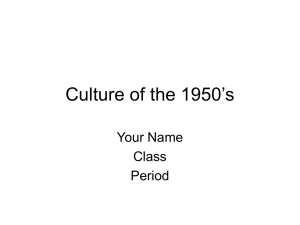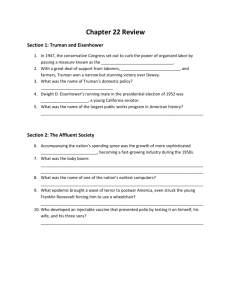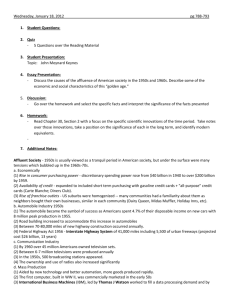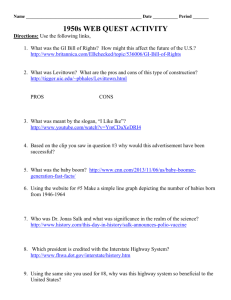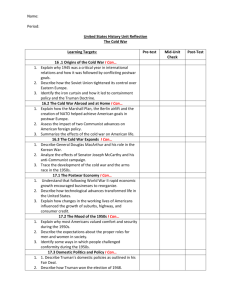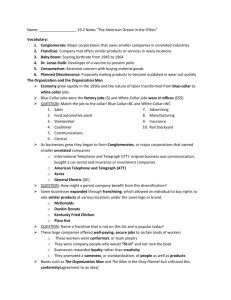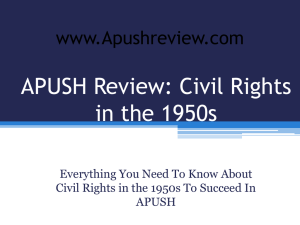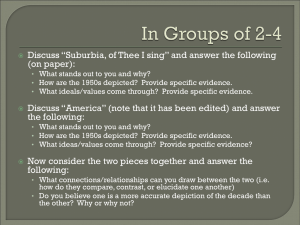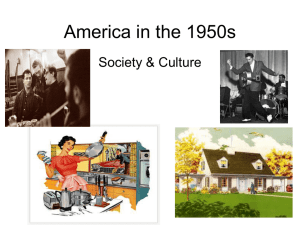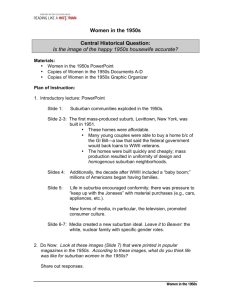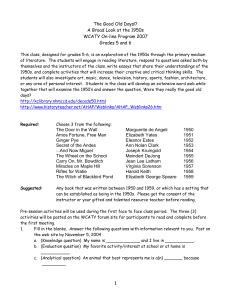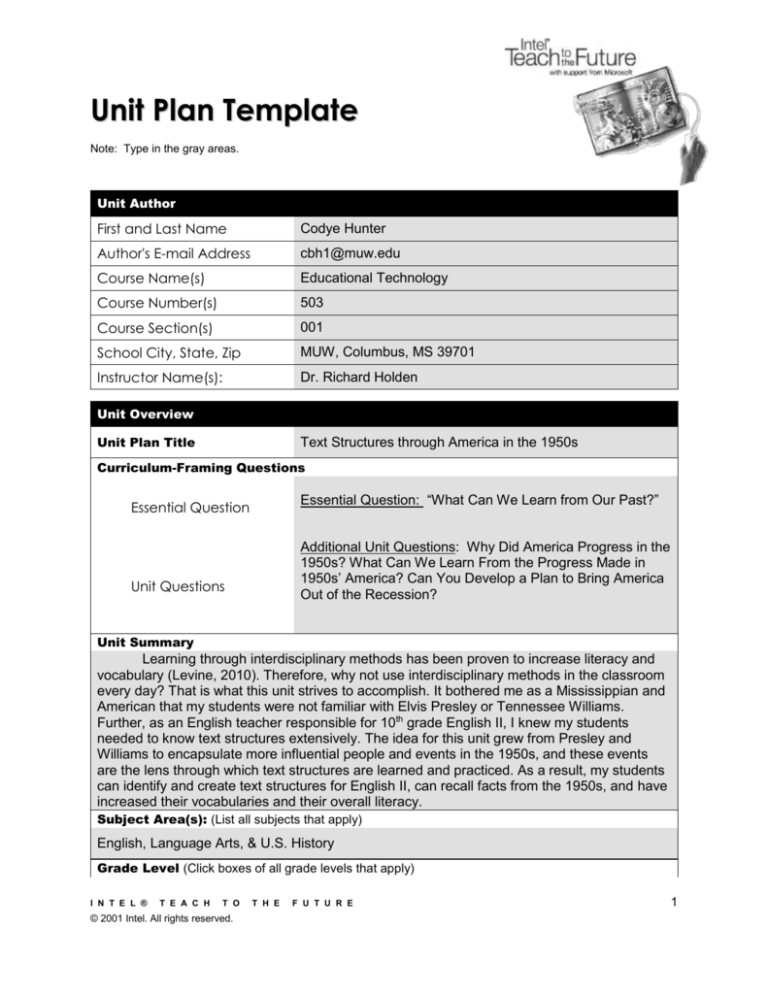
Unit Plan Template
Note: Type in the gray areas.
Unit Author
First and Last Name
Codye Hunter
Author's E-mail Address
cbh1@muw.edu
Course Name(s)
Educational Technology
Course Number(s)
503
Course Section(s)
001
School City, State, Zip
MUW, Columbus, MS 39701
Instructor Name(s):
Dr. Richard Holden
Unit Overview
Unit Plan Title
Text Structures through America in the 1950s
Curriculum-Framing Questions
Essential Question: “What Can We Learn from Our Past?”
Essential Question
Additional Unit Questions: Why Did America Progress in the
1950s? What Can We Learn From the Progress Made in
1950s’ America? Can You Develop a Plan to Bring America
Out of the Recession?
Unit Questions
Unit Summary
Learning through interdisciplinary methods has been proven to increase literacy and
vocabulary (Levine, 2010). Therefore, why not use interdisciplinary methods in the classroom
every day? That is what this unit strives to accomplish. It bothered me as a Mississippian and
American that my students were not familiar with Elvis Presley or Tennessee Williams.
Further, as an English teacher responsible for 10th grade English II, I knew my students
needed to know text structures extensively. The idea for this unit grew from Presley and
Williams to encapsulate more influential people and events in the 1950s, and these events
are the lens through which text structures are learned and practiced. As a result, my students
can identify and create text structures for English II, can recall facts from the 1950s, and have
increased their vocabularies and their overall literacy.
Subject Area(s): (List all subjects that apply)
English, Language Arts, & U.S. History
Grade Level (Click boxes of all grade levels that apply)
I N T E L ®
T E A C H
T O
© 2001 Intel. All rights reserved.
T H E
F U T U R E
1
K-2
6-8
ESL
Gifted and Talented
3-5
9-12
Resource
Other:
Student Objectives/Learning Outcomes
S.W.B.A.T. research, identify important events and people from the 1950s in America.
S.W.B.A.T. create a timeline of the 1950s.
S.W.B.A.T. compare and contrast America in the 1950s to America today.
S.W.B.A.T. construct paragraphs about the important events of the 1950s in the following text
structures: sequential, compare/contrast, description, and order of importance.
S.W.B.A.T. evaluate the current situation American is in and how strategies from the 1950s
could be used to benefit America today through a speech or paragraph.
Important events in the 1950s will include: Political events and ideas- conservatism,
consumerism, Truman, Eisenhower, Brown v. Board, Civil Rights Movement, Martin Luther
King, Jr., Rosa Parks, Alaska and Hawaii becoming states, Explorer I satellite orbiting Earth,
adding “under God” to the pledge, Federal Highway Act. Medical- deciphering DNA structure,
polio vaccine. Entertainment- Rock n Roll, James Dean, Elvis Presley, Marilyn Monroe,
national parks and Disneyland).
Targeted State Frameworks/Content Standards/Benchmarks
Mississippi Language Arts Frameworks 10th grade State Objectives 2) b.,c.,d. & 3) a.,c.,e
2b. The student will recognize text structures (e.g., description, comparison and contrast,
sequential order, cause and effect, order of importance, spatial order, process/procedural,
problem/solution) and analyze their effect on theme, author’s purpose, etc. (DOK 3)
2c. The student will make inferences based on textual evidence of details, organization,
and language to predict, draw conclusions, or determine author’s purpose. (DOK 3)
2d. The student will analyze or evaluate texts to synthesize responses for summary,
précis, explication, etc. (DOK 3)
3) The student will produce, analyze, and evaluate effective communication: a, c, e
Procedures
T.T.W. gather all appropriate materials and supplies for the lesson.
T.T.W. introduce the lesson.
T.T.W. group students into expert groups for the research lesson.
T.T.W. hand out research worksheets.
T.T.W. take the students to the library for research on the Internet.
I N T E L ®
T E A C H
T O
© 2001 Intel. All rights reserved.
T H E
F U T U R E
2
T.T.W. monitor students’ computer use.
T.T.W. conclude the research lesson.
T.T.W. create work station complete with all supplies needed to create a creative poster.
T.T.W. allow students into their same groups in order to create a poster for their selected
event or influential figure from the 1950s.
T.T.W. monitor the poster making.
T.T.W. call on groups to present their poster then place it on the class’ timeline that runs
across the top of the chalkboard.
T.T.W. administer the compare and contrast lesson.
T.T.W. administer the writing lessons.
T.T.W. give directions for the writings.
T.T.W. grade the writings and hand them back for correction.
Approximate Time Needed (Example: 45 minutes, 4 hours, 1 year, etc.)
5 hours or 5 school periods
Prerequisite Skills
High school reading level and knowledge of how to use a computer.
Materials and Resources Required For Unit
Technology – Hardware (Click boxes of all equipment needed.)
Camera
Laser Disk
Computer(s)
Printer
Digital Camera
Projection System
DVD Player
Scanner
Internet Connection
Television
VCR
Video Camera
Video Conferencing Equip.
Other:
Technology – Software (Click boxes of all software needed.)
Database/Spreadsheet
Image Processing
Desktop Publishing
Internet Web Browser
E-mail Software
Multimedia
Encyclopedia on CD-ROM
Web Page Development
Word Processing
Other:
Printed Materials
Research worksheets and Venn diagrams
Supplies
Posters, markers, tape, glue, long piece of bulletin board
paper for the class timeline.
Internet Resources
Search engine such as Google or Bing
Others
Computers and printers
I N T E L ®
T E A C H
T O
© 2001 Intel. All rights reserved.
T H E
F U T U R E
3
Accommodations for Differentiated Instruction
Resource Student
Gifted Student
Student Assessment
Informal: Research worksheet, poster, presentation, and Venn diagram
Formal: (3 or 4) paragraphs and (1) speech (if not 4th paragraph) all worth 25 points a piece
Page 4 of 4

